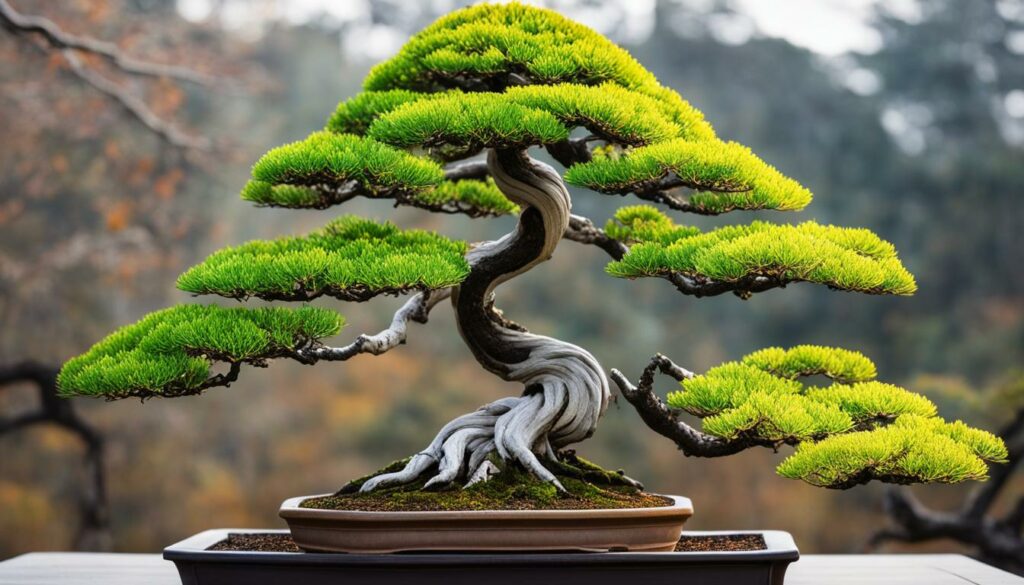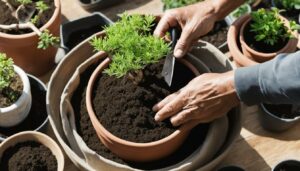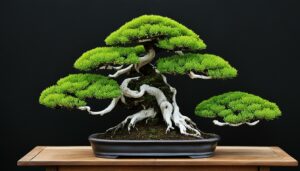If you’re new to bonsai cultivation, you may wonder how to care for these delicate trees throughout the seasons. Understanding and adapting to the different growth patterns throughout the year is crucial for the health and thriving growth of your bonsai trees. Making seasonal adjustments to your care routines is essential to ensure that your trees stay healthy and robust, no matter the time of year.
Key Takeaways
- Seasonal adjustments are essential for the health and vitality of bonsai trees.
- Understanding the natural growth patterns of your bonsai species is necessary before making seasonal adjustments.
- Caring for bonsai during each season requires specific techniques, tools, and attention.
- Adapting to geographic region and indoor growing environments is crucial.
- A bonsai cultivation calendar can help you stay organized and make the most of seasonal adjustments.
Understanding Bonsai Growth Patterns
Before making any seasonal adjustments, you must understand the natural growth patterns of your bonsai trees. Different species have varying growth cycles and specific requirements based on the climate they originate from. By familiarizing yourself with these patterns, you can better tailor your care to match the needs of your bonsai.
Bonsai trees grow according to the same basic principles as their full-sized counterparts. They require healthy roots, nutrient-rich soil, and proper sunlight and water to thrive. However, certain species may require different growing conditions, including specific levels of humidity, temperature, or air circulation.
An important part of understanding bonsai growth patterns is recognizing the role of environmental factors. Trees adapt to their surroundings, and you must consider these adaptations when cultivating bonsai. Understanding the climate the tree originated from can help you create the optimal growing environment.
As you grow more familiar with the growth patterns of your bonsai, you can look for changes in your tree that may indicate it needs more or different care adjustments. Regular observation and maintenance are key to ensuring the health and longevity of your bonsai tree.
Spring Care for Bonsai Trees
With spring comes new life and growth to your bonsai trees. As the weather warms up, your trees come out of dormancy and begin their active growth phase. During this time, it’s crucial to adjust your care routine to support the healthy development of your bonsai.
One of the most important aspects of spring care is pruning. This is the perfect time to remove any dead or damaged branches and shape your tree for the growing season. Additionally, pruning stimulates new growth and encourages lush foliage.
Another critical aspect of spring care is soil adjustment. By repotting your bonsai, you can provide fresh soil enriched with the nutrients your tree needs to thrive. Make sure to consider the specific needs of your tree’s species and adjust the soil composition accordingly.
Proper pruning techniques and soil adjustment are vital to ensure healthy spring growth and the overall health of your bonsai trees.
Don’t forget the importance of watering and fertilizing during this time. Your trees will require more water as the weather warms up, and you should adjust your watering schedule accordingly. Applying a balanced fertilizer will also help promote healthy foliage growth and support the nutrient needs of your tree.
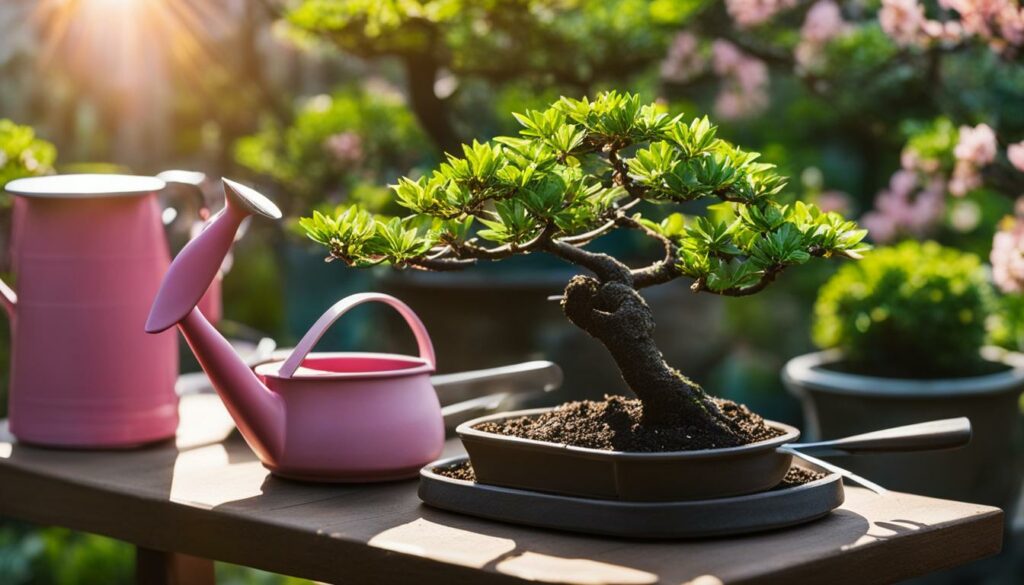
Remember, spring is a critical time for bonsai cultivation, and the proper seasonal adjustments are crucial for the health and success of your trees.
Summer Care Tips for Bonsai
Summer can be a challenging season for your bonsai trees, but with some care adjustments, you can ensure their healthy growth and development even during the intense heat and longer days. Here are some tips to keep in mind:
Protect Your Trees From Sunburn
Direct sunlight can scorch your bonsai’s leaves and bark, leading to long-term damage. You can protect your trees from the sun by moving them to a slightly shadier area or using shade cloth to filter the harsh sunlight. Additionally, make sure to water your trees thoroughly to prevent dehydration.
Provide Sufficient Watering and Humidity
Summer can cause the soil to dry out quickly, and your bonsai may require more frequent watering to keep them healthy. However, be careful not to overwater your tree, which can cause root rot. To maintain moisture, you can use a humidity tray or mist your tree every morning.
Manage Pest Control
Unfortunately, warm weather can attract pests like spider mites and aphids. To avoid infestations, make sure to keep your trees clean and remove any dead or dying leaves or branches. You may also need to use insecticidal soap or neem oil to control the pests.
By following these summer care tips, you can help your bonsai trees thrive even during the hottest months of the year. Remember to keep an eye on your tree’s growth and adjust your care routine as needed to ensure their health and longevity.
Autumn Maintenance of Bonsai Trees
With the arrival of autumn, it’s time to give your bonsai trees the attention they need to prepare for winter dormancy. Autumn maintenance involves a range of seasonal adjustments and techniques to keep your trees healthy and thriving. Here are some best practices to follow when caring for your bonsai in the autumn season:
Pruning
Pruning is crucial during autumn maintenance as it helps prevent your bonsai from becoming overgrown and allows for proper air circulation and sunlight exposure. Remove any dead or damaged branches, as well as any growth that doesn’t fit the desired shape or size of your tree. Take care not to over-prune, as this can weaken your tree and leave it vulnerable to pests or disease.
Repotting
Autumn is a great time to repot your bonsai trees if necessary. Repotting helps refresh the soil and promote healthy root development. Be sure to choose the right soil type and container size for your tree, and take care when transplanting to avoid damaging the roots.
Protection from Frost
As temperatures drop, it’s essential to protect your bonsai from frost and freezing. Cover your trees with a frost cloth or blanket, and be sure to move them indoors if the temperature drops too low. Don’t forget to water your trees regularly, as dehydration can be a severe risk during cold months.
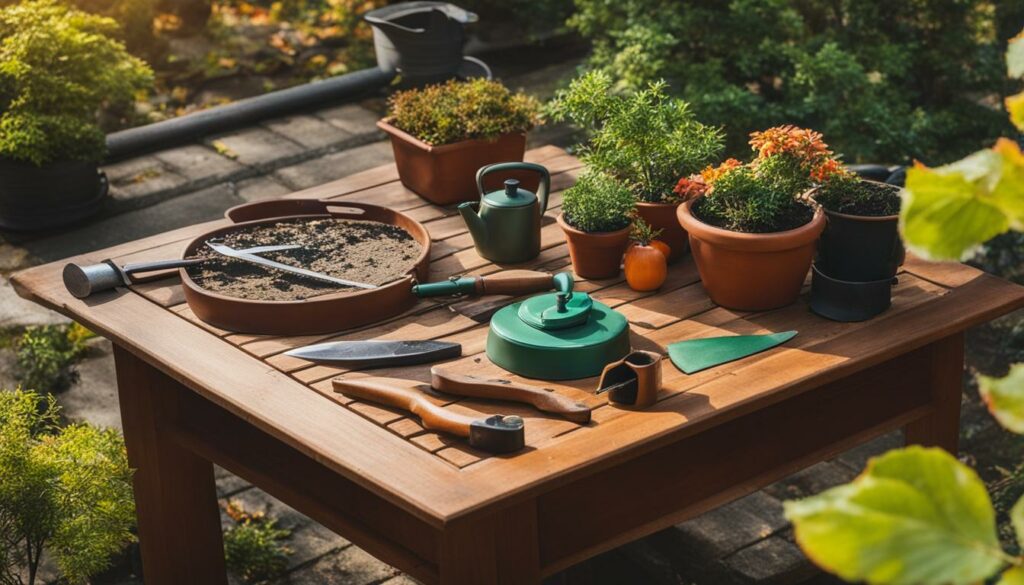
Autumn maintenance is a vital part of bonsai cultivation, and by following these best practices, you’ll help ensure the health and longevity of your trees. By properly pruning and repotting your bonsai and protecting them from freezing temperatures, your trees will be ready to enter into winter dormancy and emerge healthy and vibrant in the spring.
Winter Care for Bonsai Trees
During the winter season, your bonsai tree enters a period of dormancy, and proper care during this time is crucial for its health. To create an optimal winter environment for your tree, make the following temperature, watering, and protection adjustments:
| Winter Care Adjustments: | How-to: |
|---|---|
| Temperature Control: | Keep your bonsai tree in a cool location, away from direct sunlight and drafts. Protect the tree’s roots from freezing by placing the pot on top of insulating material, such as foam or cork. |
| Watering Adjustments: | Reduce the frequency of watering during winter, as the tree will not need as much moisture during dormancy. Be careful not to let the soil dry out completely, but do not overwater. Check the soil frequently to ensure proper moisture levels. |
| Protection from Freezing: | Protect your bonsai tree from freezing temperatures by wrapping the pot in insulation, such as burlap or bubble wrap. For outdoor trees, consider placing them in a sheltered area or covering them completely. |
Proper winter care and protection will ensure that your bonsai tree comes out of dormancy healthy and ready for spring growth.
Adjusting Care Based on Geographic Region
Bonsai cultivation requires different care adjustments based on the geographic region. Understanding the unique climate characteristics of your location is crucial for successfully growing your bonsai trees.
If you are located in a dry and hot environment, such as Arizona or Nevada, you’ll need to increase humidity for your trees to thrive. This can be achieved through frequent misting, grouping your trees together to create a more humid environment, or conserving moisture through diligent soil management.
In contrast, if you reside in a colder region like Maine or Minnesota, your trees will face freezing temperatures during the winter months. It’s important to prepare your bonsai through winterization techniques like adding a protective layer of mulch or placing them in sheltered areas away from extreme weather exposure.
Coastal regions like Miami, Florida, and Seattle, Washington experience higher levels of moisture in the air, making them more susceptible to fungal diseases. It’s essential to promote good ventilation by not overcrowding trees and regularly pruning to avoid excessively damp conditions.
By knowing the climate characteristics of your geographic region, you can make informed seasonal adjustments to your bonsai cultivation.
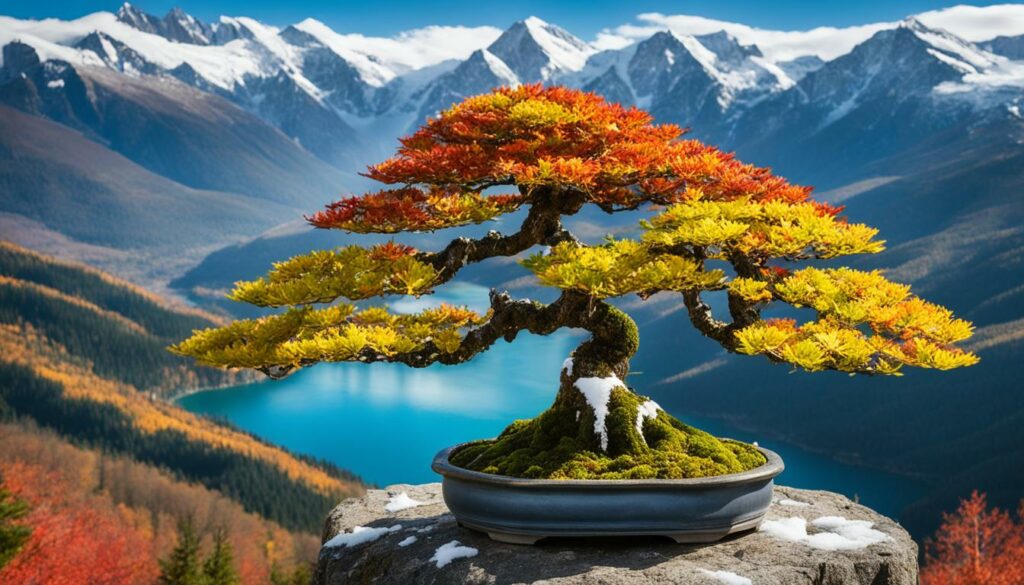
Troubleshooting Seasonal Issues in Bonsai Care
Despite your best efforts in bonsai care, seasonal changes can bring up various issues that may affect the health and appearance of your tree. Here are some of the common issues faced during seasonal adjustments:
| Issue | Cause | Solution |
|---|---|---|
| Pest infestation | Weak bonsai defense, uncontrolled environment | Keep your bonsai clean and free from debris, maintain proper watering and humidity levels, use organic pest controls if necessary |
| Diseases and fungal infections | Low-quality soil, poor drainage, uncontrolled environment | Use quality bonsai soil, ensure proper drainage, avoid overwatering, and clean pruning tools to prevent cross-contamination |
| Yellowing and withering leaves | Overwatering, under-watering, nutrient deficiency, uncontrolled environment | Check watering levels, improve soil quality, adjust nutrient levels, and maintain optimal environmental conditions |
If you notice any unusual changes in your bonsai’s growth and appearance, act quickly to diagnose and remedy the problem. With proper care and attention, your bonsai can rebound and thrive – even after stressful growing periods.
In addition, you can avoid many seasonal issues by providing appropriate care adjustments based on each season. Regularly monitoring your bonsai’s health and adapting care routines as needed will help prevent severe problems from arising.
Next, let’s learn about the essential tools needed for a successful seasonal adjustment in bonsai cultivation.
Tools for Seasonal Adjustments in Bonsai Care
Proper bonsai care requires a set of essential tools to ensure the optimal health and growth of your trees throughout the year. With the right tools, you can effortlessly make the necessary seasonal adjustments. Here are some must-have tools for seasonal bonsai care:
| Tool | Function |
|---|---|
| Bud Shears | Cutting small branches, twigs and bud pinching. |
| Root Hooks | Untangling roots and spreading them evenly to help nutrient absorption. |
| Concave Cutters | Succesful removing of branches without leaving scars or damaging the trunk. |
| Bonsai Tweezers | Removing insects, shaping and other fine detailed adjustments. |
| Wire Cutters / Pliers | Bending and shaping branches as to how artist envision it to be. |
| Bonsai Scissors | Pruning for maintaining healthy foliage and boosting root growth. |
| Watering Can | Providing the enough water according to the season and making sure the water is distributed evenly. |
| Bonsai Soil Mix | Providing the right soil composition for the current stage of the bonsai. |
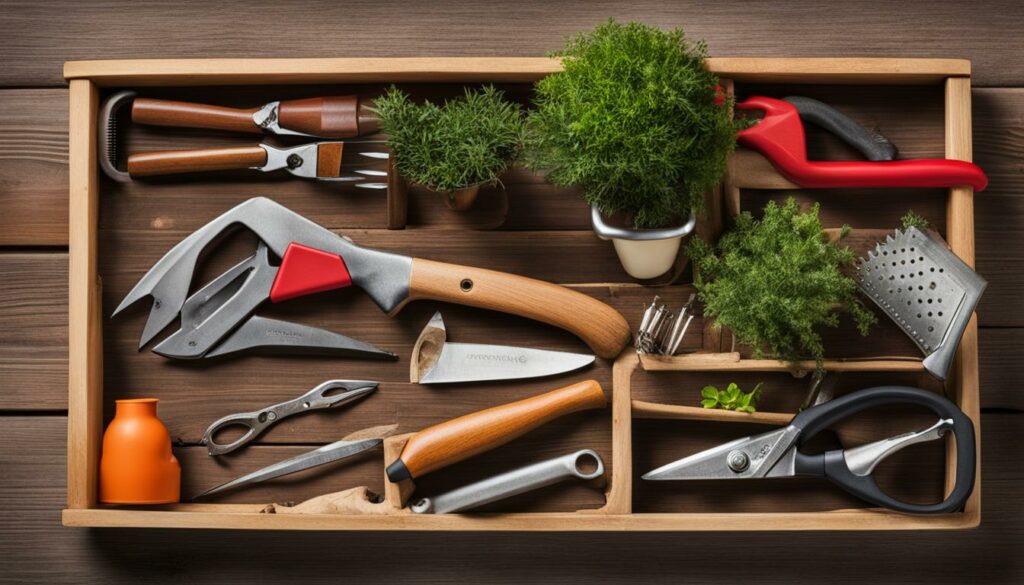
These tools will help you prune, repot, and maintain the overall health of your bonsai trees. When selecting your tools, always prioritize quality over cost. Invest in high-quality tools that will last longer and provide better results. Keeping your tools clean and sharp is also crucial to prevent the spread of disease and ensure precision pruning.
Training Techniques and Seasonal Adjustments
Proper training techniques can go a long way towards shaping your bonsai into a desired aesthetic while maintaining healthy growth. And seasonal adjustments are an integral part of successful bonsai cultivation. How do these two practices intersect?
First, it’s important to understand how the changing seasons affect your bonsai. During the active growth phase in spring and summer, you want to encourage new growth and support foliage development. This may involve utilizing pruning techniques to shape your tree and encouraging healthy root growth with frequent watering and feeding.
As temperatures cool down in autumn, it’s time to prepare your bonsai for dormancy. This may require pruning back foliage to reduce water loss and protect delicate branches from harsh winds. Additionally, you’ll want to focus on preparing your tree’s root system for the winter season.
During winter, your bonsai will enter dormancy, and you’ll need to adjust your care routine accordingly. This includes changing your watering and feeding schedule and providing appropriate temperature control to protect your tree’s delicate roots from freezing conditions.
When it comes to training and shaping bonsai, these seasonal adjustments provide the ideal timing for pruning and shaping your tree. For example, in the active growth phase of spring and summer, you may want to utilize wiring techniques to shape branches and encourage the development of a desired aesthetic. During the dormant phase in winter, you may have the opportunity to repot your tree and adjust its positioning to create the ideal visual presentation.
Overall, understanding seasonal adjustments and incorporating them into your training techniques can make all the difference in the health and appearance of your bonsai tree.
Adapting Indoor Bonsai to Seasonal Changes
Indoor bonsai care requires special attention to replicate the seasonal changes they would experience in their natural habitat. Without proper adjustments, your indoor bonsai may struggle to maintain good health and growth. Below are key considerations for adapting your indoor bonsai to seasonal changes:
Light and Temperature Adjustments
The first step in adapting your indoor bonsai to seasonal changes is making light and temperature adjustments based on the time of year. During the winter months, days are shorter, and sunlight is weaker, meaning that you may need to supplement your indoor bonsai with artificial light. Alternatively, during the summer months, intense heat may require moving your bonsai to a cooler, shadier location. Proper temperature control is also essential for maintaining healthy indoor bonsai.
Watering and Fertilizing Adjustments
Watering and fertilizing indoor bonsai also require season-specific adjustments. During the winter months, indoor heating can dry out the air, leading to moisture loss in the soil of your bonsai. Try using a humidifier or placing a tray of water near your bonsai to increase moisture levels. Conversely, during the summer months, your indoor bonsai may require frequent watering to prevent soil from drying out. Proper fertilization is also crucial for maintaining healthy indoor bonsai. During the growing season, you’ll need to provide regular fertilization, while during the dormant winter months, fertilization should be reduced.
Repotting and Pruning Adjustments
As with outdoor bonsai, indoor bonsai require repotting and pruning at specific times during the year. Repotting should occur during the spring or fall seasons, while pruning should happen after the bonsai’s growing season and before its dormant season. Additionally, during the winter months, pruning should be minimal to conserve energy for the dormant season.
By making these seasonal adjustments in indoor bonsai care, you can help your bonsai thrive year-round and maintain its health and beauty. Remember to monitor your indoor bonsai carefully during each season and make necessary adjustments as needed.
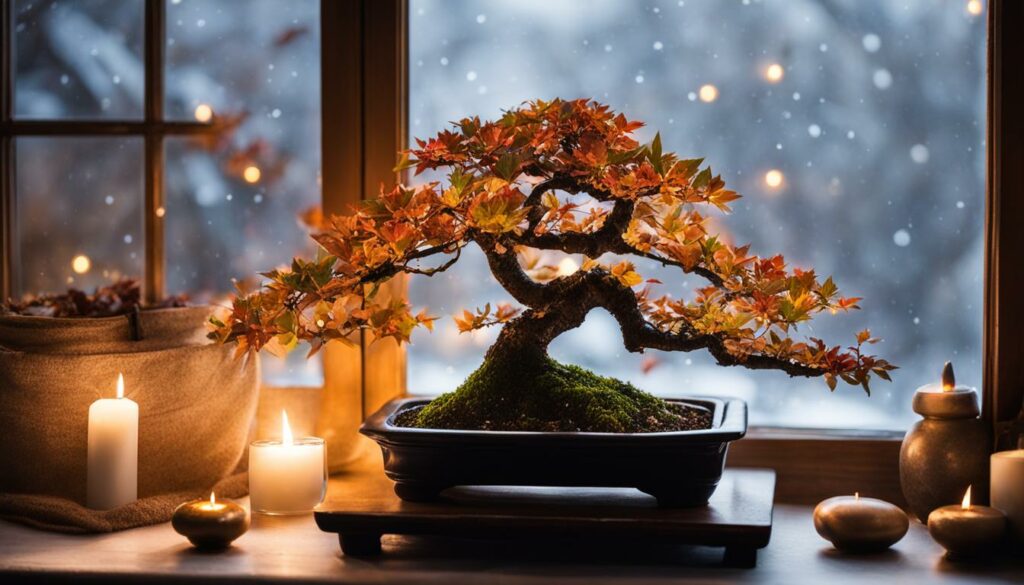
Bonsai Cultivation Calendar
To ensure your bonsai thrives throughout the year, it’s crucial to keep track of seasonal adjustments and care tasks. A bonsai cultivation calendar can help you stay organized with reminders and guidance on the necessary adjustments to support healthy growth. Here are the key milestones to include in your calendar:
| Season | Tasks |
|---|---|
| Spring |
|
| Summer |
|
| Autumn |
|
| Winter |
|
Note that the tasks listed are general, and you should adjust them based on the specific species and climate of your bonsai. By following a cultivation calendar tailored to your trees, you’ll be able to promote healthy growth and prevent potential issues.
Stay on top of seasonal adjustments and care tasks with a bonsai cultivation calendar to support the thriving growth of your trees.
Conclusion
Now that you understand the importance of seasonal adjustments in bonsai cultivation, it’s time to put your knowledge into practice. Remember to tailor your care routine to fit the specific needs of each tree based on its growth patterns and geographic region.
By implementing the suggested care adjustments throughout the year, you’ll be able to promote healthy growth, prevent common issues, and create stunningly beautiful bonsai trees. Don’t forget to use the right tools, stay organized with a cultivation calendar, and adjust your training techniques to incorporate seasonal changes.
With dedication and attention to detail, you’ll be able to enjoy the beauty and art of bonsai throughout the year. Happy cultivating!
FAQ
Why are seasonal adjustments important in bonsai cultivation?
Seasonal adjustments are crucial in bonsai cultivation because different seasons bring varying growth patterns and environmental changes. By adapting your care routines to match the needs of each season, you promote the health and thriving growth of your bonsai trees.
How can I understand the growth patterns of bonsai trees?
Understanding the growth patterns of bonsai trees requires familiarizing yourself with the specific requirements and natural cycles of different species. By researching and observing your bonsai, you can gain insights into its growth habits and tailor your care accordingly.
What care adjustments should I make during spring?
During spring, you should focus on supporting healthy foliage development, promoting root growth, and practicing appropriate pruning techniques. Additionally, it’s essential to adjust watering and light exposure to meet the increased growth needs of your bonsai trees.
How do I care for my bonsai during the summer months?
Summer care for bonsai trees involves protecting them from sunburn, providing sufficient watering and humidity, and managing pest control. It’s important to keep an eye on watering frequency as the heat increases and adjust your care routine accordingly.
What maintenance tasks should I perform during autumn?
In autumn, you should focus on pruning, repotting, and protecting your bonsai trees from frost and freezing temperatures. These tasks prepare your trees for the upcoming winter dormancy and ensure their health and resilience.
How do I care for bonsai trees during the winter?
Winter care for bonsai trees involves creating the optimal winter environment, including temperature control, adjusting watering frequency to prevent root freezing, and protecting delicate roots from freezing conditions. It’s crucial to monitor your bonsai’s water intake during this dormant period.
How can I adjust my care routines based on my geographic region?
Different geographic regions have unique climate characteristics, and it’s important to adapt your care routines accordingly. Understanding your local climate and its impact on bonsai cultivation can help you make appropriate adjustments throughout the seasons.
What should I do if my bonsai encounters seasonal issues?
If your bonsai encounters seasonal issues, it’s important to identify the problem and take appropriate action. This may involve adjusting watering, fertilizing, or addressing specific pest or disease concerns. Troubleshooting guides can provide guidance in addressing common seasonal problems.
What are the essential tools for seasonal adjustments in bonsai care?
The essential tools for bonsai care include pruning shears, concave cutters, root hooks, wire cutters, and bonsai soil. These tools allow you to perform tasks such as pruning, repotting, and maintaining the overall health of your bonsai trees throughout the seasons.
How can I incorporate seasonal changes into bonsai training techniques?
Seasonal changes play a significant role in training and shaping bonsai trees. By adjusting your training techniques based on the growth patterns and needs of each season, you can achieve desired aesthetics and promote healthy growth in your bonsai.
How do I adapt indoor bonsai trees to seasonal changes?
Adapting indoor bonsai trees to seasonal changes involves replicating the environmental conditions that they would experience in their natural habitat. This includes adjusting lighting, temperature, and watering regimes according to the different seasons and growth requirements.
What is a bonsai cultivation calendar?
A bonsai cultivation calendar is a tool that helps you stay organized and on track with seasonal adjustments in bonsai care. It provides guidance on specific tasks and care adjustments to be made throughout the year, ensuring that you meet the needs of your bonsai at the right time.
Why is implementing seasonal adjustments important in bonsai cultivation?
Implementing seasonal adjustments is important in bonsai cultivation because it allows you to provide the optimum care for your trees at different stages of their growth and development. By addressing specific seasonal challenges and adapting your care routines, you can ensure the long-term health and beauty of your bonsai trees.
